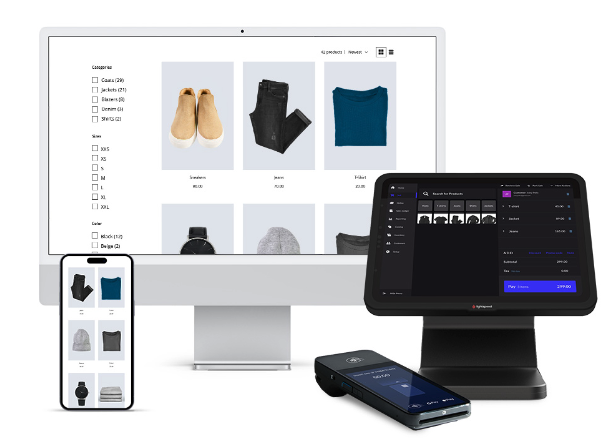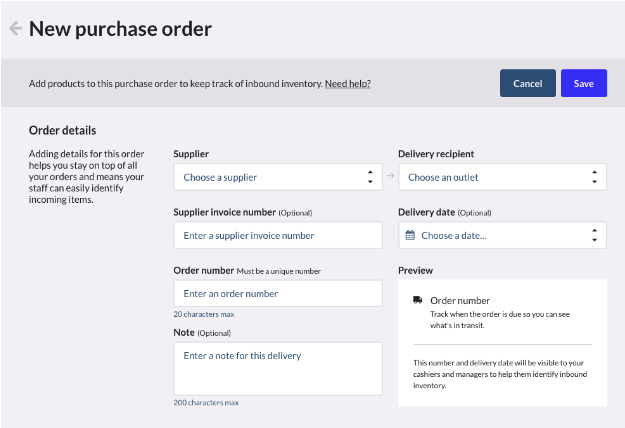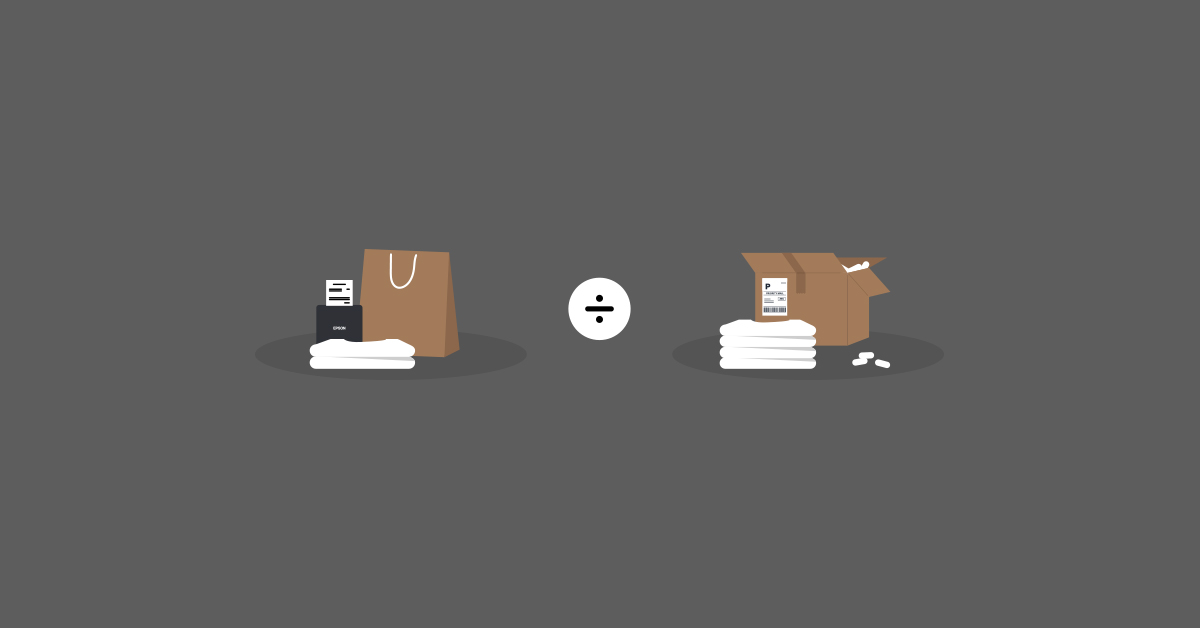
Managing your inventory and ordering supplies is an essential part of running your business. Unfortunately, it can be incredibly tedious, time consuming, and can often become an administrative nightmare if you’re not organised enough or if you don’t have the right tools to make the process more efficient. That’s where purchase orders come in.
Purchase orders are a really important resource your business needs to ensure a well-managed purchasing process. Let’s get started.
In this article, you’ll learn:
- Definition of a purchase order
- Purpose and benefits of purchase orders
- Challenges and drawbacks of purchase orders
- Key components of a purchase order
- How to create a purchase order
- How to create a purchase order in Lightspeed Retail
- Types of purchase orders
- Difference between a purchase order number and an invoice
- How to manage purchase orders
Purchase Order Template
Download our free purchase order template to help standardise your ordering process, ensure accurate record-keeping, and save time.
Definition of a purchase order
A purchase order (PO) is a document sent from a business to a supplier to authorise a purchase. POs allow businesses to show their intention to buy goods from a supplier, and how much of it they would like to buy.
POs will lay out the order details including the types, quantities, and prices of the products or services being purchased by the buyer. They will also include details like payment terms and delivery details. Each PO has a unique PO number associated with it that helps both buyers and suppliers track delivery and payment.
Purpose and benefits of purchase orders
We’ll be honest with you, we wouldn’t be writing an article on ‘what you need to know about purchase orders’ if we didn’t think they were worth your time. POs promote greater organisation, order transparency, financial forecasting, and much more. We could go on and on, but we’ll keep it short and sweet and cover the main benefits below.
The various purposes of purchase orders
Inventory control: Purchase orders help retailers manage their inventory levels with more accuracy. By issuing POs, they can ensure that they stock the right amount of each item to meet consumer demand without overstocking, which can tie up capital, raise storage costs and lead to obsolete inventory, which is a loss for the business.
Audit and compliance: Purchase orders serve as an audit trail that details all purchasing activities. This is important not only for internal financial audits but also for compliance with regulatory standards. They provide transparency into the procurement process, which is essential for accountability and compliance.
Financial planning and budget management: Retailers use purchase orders to track spending and stick to their budgets. Each PO is a commitment to pay, and tracking these commitments helps retailers maintain control over their finances, avoid overspending and budget more efficiently for the long-term.
Legal documentation and protection: Once a PO has been accepted by a supplier, it becomes a legally binding agreement. It protects both the retailer and supplier in the event of disputes over deliveries, such as discrepancies in the quantity or quality of goods received.
Streamlining procurement: Purchase orders standardise the buying process, which helps retail businesses organise their procurement activities. The process as a whole becomes systematic and efficient. Standardisation can help improve the speed of business operations.
Benefits of purchase orders
Formalising the agreement: A PO formalises a buyer’s intent to purchase goods or services from the seller. Each PO acts as a ‘contract’ ensuring that there is a written record and agreement of an order between two parties. This can be used as evidence in the case of any legal disputes, too.
Enhanced supplier relations: Regular and clear POs can help you build strong relationships with suppliers. They set clear expectations and effectively communicate needs, which can lead to better service, reliability and potentially more favourable terms.
Specification of goods or services: The PO includes detailed information about the products or services being ordered, such as descriptions, quantities and prices of what has been ordered. So, there’s no confusion or misunderstanding when it comes to what has been ordered, and what is expected. This helps maintain product quality.
Tracking and record-keeping: If every order you made to a supplier was over a call on the phone, or even something like an email, it would be difficult to keep track of what has been ordered. POs allow your business, and your supplier, to facilitate effective record-keeping. That way, you can provide a documented trail of transactions, which is valuable for accounting, auditing and inventory management purposes.
Budget control: Cash flow management is an important part of any successful business, and POs can help support this. They can help organisations manage and control their spending more effectively, as businesses know of the agreed-upon prices and quantities in advance.
Challenges and drawbacks of purchase orders
Of course, while POs are considered by many to be an integral part of any efficient retail machine, there can be some slight challenges that you can encounter, especially if you’re not careful.
Administrative burden: This isn’t too much of a drawback, as every job involves a little bit of admin every now and then, but creating POs can sometimes be a pain. Creating, processing, and managing POs can be time-consuming and require some administrative effort, especially if your business makes a high volume of orders.
Delays: You can experience delays when it comes to finalising POs as you may sometimes have to obtain approvals. Or, there might be discrepancies or changes to the order that might need to be addressed. However, it must be said, these are due to user error rather than being an integral flaw of a purchase order.
Potential for errors: Nobody’s perfect–errors are a part of every job. So, there can be a risk of producing errors when creating POs, such as incorrect item descriptions, quantities, prices, or delivery dates. This is especially the case if you’re creating a lot of them and have gone on auto-pilot. These errors can lead to confusion, delays and additional costs.
Increased complexity: As your business grows and your transaction volume increases, so too can the complexity of managing purchase orders. This added complexity can lead to errors, such as duplicate orders, or issues with order tracking and reconciliation.
Potential for inflexibility: POs often require you to lock in certain conditions, like price and quantity, which could limit your flexibility. Changes in market conditions or business needs might call for adjustments that are difficult to implement once a PO is issued and accepted.
Key components of a purchase order
Now know what the good, the bad, and the ugly of POs are. Except there isn’t much bad or ugly unless you fill them out wrong. And, now, you’ve decided to start creating your own. Great! Before we get started with creating your own, let’s run through all the different components of a PO so you know what you’re looking at.
The standard PO form will include:
- Your company’s name/the supplier’s name
- Purchase order date
- Items (SKUs, model numbers, description, quantity, etc.)
- Price per unit
- Payment terms
- Shipping information (e.g. delivery address / billing address)
- Expected delivery date
How to create a purchase order
We’ll cut to the chase, you can find our purchase order template here if you want to get started. Here’s an example of what it will look like:

Once you’ve created a PO (hopefully using our template), you’ll next need to use it to order some stock. Each retailer’s process can differ, but here’s a general example of how a purchase order process looks:
- The buyer decides to purchase a product for their business.
- The buyer issues a PO to the supplier, oftentimes electronically using a PO template.
- The supplier receives the PO and confirms to the buyer that they can fulfil the order. If not, the supplier lets the buyer know and the PO is cancelled.
- If the supplier can fill the order, they start preparing the order by pulling the requested inventory and scheduling personnel to package and ship the order.
- The order is shipped to the buyer’s specified delivery location with the PO number on the packaging list.
- The supplier invoices the buyer for the order using the PO number so that it can be quickly matched with the shipment’s delivery information.
- The buyer pays the supplier according to the invoice terms specified in the PO.
How to create a purchase order in Lightspeed Retail POS

Creating your own POs from scratch is fine. But, it’s old school. It’s time to join the 21st century. Lightspeed Retail’s inventory management system has an integrated purchase order management system built in. So, that means less time dealing with clunky Excel spreadsheets, and more time growing your business. Doesn’t that sound easier?
If you want to learn more about how you can automate and streamline your order management system, you can click here to learn more.
Already using Lightspeed? If you’re interested in seeing how to batch import items into a purchase order, set automated reorder points, or build special orders, check out our Help Center article on creating purchase orders.

Related: Check out the ultimate guide to inventory management for retailers.
Types of purchase orders
There are four types of POs that a retailer can use, each with their own use cases and benefits.
Standard purchase orders: Just like the name suggests, standard POs are the most commonly used. In a standard PO, the buyer specifies:
- The items they’re buying
- The quantity of each item they’re buying
- The delivery location and date
- Payment terms
Planned purchase orders: When a buyer places a planned PO, they anticipate their future needs for an item and submit a PO in advance. In a planned PO, the buyer specifies:
- What items they’re buying
- The cost of those items
- The delivery location
- Payment terms
For planned POs, the quantity of items is based on an estimation and delivery dates are tentative, usually within a set timeframe (for example, anytime between November 1-15).
Blanket purchase orders: Blanket POs are a commitment from a buyer to buy products or services from a supplier on an ongoing basis until a specified order value is reached. Usually, the buyer places multiple orders at the same time to benefit from preferential pricing.
Contract purchase orders: Both the buyer and supplier sign a contract that specifies the terms of the purchase before a PO related to the contract is issued. While the penalties for breaching a contract PO vary, both the supplier and buyer have the ability to take legal action should the other party not fulfill their end of the contract.
The main benefit of contract POs is that they offer more legal protection for both buyers and suppliers. Typically, we see contract POs for large orders where buyers want legal backing should a supplier make errors, or suppliers want assurance that the buyer will pay them in a timely fashion.
Difference between a purchase order and an invoice
The main difference between a purchase order and an invoice is who creates the document. A buyer creates a purchase order, which needs to be fulfilled by the supplier. A supplier prepares an invoice for the order and issues it to the buyer.
For example: Let’s say a clothing store is running low on t-shirts. The retailer (buyer) prepares a purchase order that lists exactly what types of t-shirts they want (size, colour, quantity, price, SKU number) as well as their desired delivery date, delivery location and billing address.
If the supplier can fulfil the purchase order, they will accept the order, which forms a legally binding contract between the buyer and supplier. Once the buyer receives the goods they ordered, they initiate a payment to the supplier for having provided the products or services specified in the purchase order.
In a nutshell, a purchase order is for a buyer to order products, whereas an invoice is for a supplier to get paid by the buyer for supplying the products.
How to manage purchase orders
Purchase orders can be relatively straightforward, but they can still add complexity to your supply chain process if you’re not accustomed to using them. For retailers, it’s important to invest in solid inventory management software and find a process to manage suppliers that works for you.
Here are a few tips for managing purchase orders:
Use technology to streamline inventory management
The best thing you can do for managing purchase orders is investing in a retail point of sale system with great inventory management capabilities. Lightspeed Retail has integrated buyer catalogues and merchants can create and send purchase orders within the system. Plus, everything is documented and stored on the cloud, so you never lose important information.
Colorado retailer The White Orchid has streamlined their inventory management with Lightspeed. With 7,500 SKUs to order, track and sell every year, founder Diane Muno’s old system limited her and led to operational inefficiencies. Plus, it was more difficult to keep up with the evolving needs of her customers.
Now with Lightspeed, Diane can see real-time inventory updates, providing her with the flexibility she needed to manage her inventory.
Diane also utilises the NuORDER by Lightspeed integration, a B2B commerce platform that allows you to order products and use product information from suppliers. With the two tools, her buying process has been streamlined.
“Instead of me having to take pictures of everything and having to make notes, Lightspeed and NuORDER allow me to have immediate access and edit my order based on budget after the fact,” Diane says.
Order in bulk to lower costs (if you can)
By ordering items in bulk, buyers can benefit from preferential item pricing and a lower cost per unit. Of course, by ordering in bulk you’re spending more upfront, so you should only explore this option if your business is stable and you’re confident you can sell the merchandise.
Be timely to foster great relationships with suppliers
Always send your purchase orders, invoices and contracts in a timely manner. Not only will that assure that you have a predictable, steady flow of the inventory you need, but suppliers will appreciate your professionalism, have confidence in your ability to pay them, and want to continue working with you.
Use the right solution for your retail business
The reality is that no two businesses are exactly the same and neither are their inventory management needs. Want to learn how Lightspeed Retail can simplify your inventory management, from ordering to organizing and selling? Talk to our team of retail experts for a free consultation.

News you care about. Tips you can use.
Everything your business needs to grow, delivered straight to your inbox.


